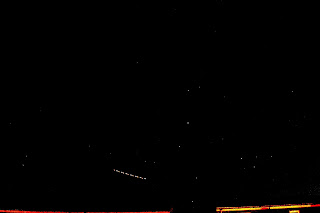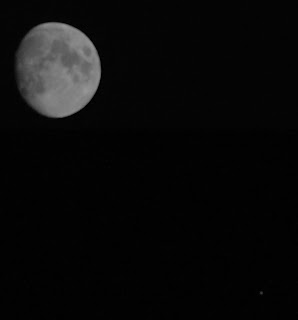July 31st 2140 GMT
I checked for Perseid and other meteors until 2200 GMT, as I had work the next day. I did not see any but had my camera aimed at Cassiopeia at 16mm focal length, ISO 6400 and 8 seconds exposure. However, the 52 frames of Cassiopeia stacked nicely.
July 29th 2300 GMT
Most of the sky was covered by cloud but I decided to see if I could catch a meteor on camera. I set my DSLR at 16mm focal length, ISO 6400 and 8 seconds exposure.
After half an hour, I had not seen any meteors in the direction of Perseus and Cassiopeia and conditions had become even worse.
Despite the awful conditions, I caught Perseus and an aircraft trail.
July 24th 2135 GMT
I took some shots of Jupiter at 300mm focal length, ISO 6400 and 1 second exposure.
July 24th 1430 GMT
I checked the Sun in hydrogen alpha light with my PST and DSLR. It seemed very quiet.
July 24th 0935 GMT
I snapped the Moon using the same settings as the day before.
July 23rd 0620 GMT
Before leaving for work, I took some shots of the Moon with my DSLR at 300mm focal length, ISO 400 and 1/1000 second exposures.
July 21st 2200 GMT
I was hoping to capture Jupiter using my Mak, DSLR and webcam. My first set of frames attempted to capture the moons with my Mak and DSLR. They failed, mostly because I didn't have a remote shutter release.
My next set of frames captured the equatorial cloud belts but words like great, iconic and awe-inspiring did not apply.
I did two imaging runs with my Bresser Electronic Eyepiece but neither worked. Cloud did not help but extinction was also an issue. My attempts with my DSLR and 3x Barlow lens did not reveal anything either!
I was hoping to capture Jupiter using my Mak, DSLR and webcam. My first set of frames attempted to capture the moons with my Mak and DSLR. They failed, mostly because I didn't have a remote shutter release.
My next set of frames captured the equatorial cloud belts but words like great, iconic and awe-inspiring did not apply.
I did two imaging runs with my Bresser Electronic Eyepiece but neither worked. Cloud did not help but extinction was also an issue. My attempts with my DSLR and 3x Barlow lens did not reveal anything either!
July 21st 2345 GMT
I was originally thinking about a session with my Mak and Bresser Electronic Eyepiece but my back was playing up a bit and I was tired from working.
I took some frames of the Moon at ISO400, 300mm focal length and 1/1000 second exposure, with my DSLR. I then used 1 second exposure for Jupiter's moons.The Jupiter shots did not work.
I came back indoors and changed lenses to attempt to capture meteors, as the Perseid shower was near its start. I saw one at 0005 GMT and a couple of sporadic meteors at 0010 GMT. Although I stayed out for another half hour, I did not see any more, although I saw a pass of the International Space Station.
I used 16mm focal length, ISO 6400 and 6 seconds exposure, aiming my camera at Cassiopeia.
I installed Sharpcap 2.9 on my computer and ran some stability tests with my Bresser Electronic Eyepiece. Naturally, although they worked, I was wondering what might happen when I would try to image the Moon or a planet.
July 16th 2108 GMT
It was the evening of the lunar eclipse. After a lot of experimentation, I settled on an exposure time of 1/100 second, ISO 400 with my DSLR at 300mm. I also took some frames of Jupiter, hoping to catch the moons. Conditions were quite poor, with lots of haze.
July 15th 2100 GMT
I took some snaps of the Moon and separate snaps of Jupiter with the usual camera settings.
July 15th 1210 GMT
I checked the Sun in hydrogen alpha light and it appeared to show some minor activity around the limbs. Underwhelming was the best word to describe the Sun at the time.
July 14th 2215 GMT
The moon was waxing gibbous and its haze was obscuring nearly all of the stars. I took some snaps of the Moon, Jupiter and Saturn with my Mak and DSLR. I originally intended to use my Bresser Electronic Eyepiece but I was having problems re-installing software on my PC.
After some experimentation, I settled on 1,54m focal length, ISO 100 and 1/1000 second exposure.on the full lunar disc.
I did several shots of Jupiter but it was an over-exposed frame that led to my best result of the year (so far).
Similarly, for Saturn,
I did not catch Titan "on film" but captures three of Jupiter's moons, so I combined the photo with the one of Jupiter to achieve the image below.
July 13th 2140 GMT
It had been cloudy for most of the day but it was almost clear near the Moon. Jupiter was nearby. Although I caught the two objects close together, I could not capture Jupiter's moons in the Moon's glare.
This was the best of the Moon shots.
Jupiter showed quite well in later frames, so I combined one with the Moon shot, above, to produce this:
I had bad focus and Jupiter's moons were lost in our moon's glare. so that was the final image.
July 12th 2145 GMT
The sky was partially clear. I took some photos of the Moon at ISO 400 300mm focal length and 1/4000 second exposure.
July 8th 2100 GMT
I used the same settings as the evening before to snap the Moon.
July 7th 2100 GMT
The Moon was about four days past new and a few features were visible in its crescent phase.
I took a set of shots at 1.54m focal length, ISO 100 and 1/100 second exposure.
I took further sets of shots at 4.62m focal length, ISO 400 and 1/50 second exposure, after a lot of fiddling. Unfortunately, I didn't get focus.
July 7th 1500 GMT
The Sun was high and the Big Bear images showed a plage and some filaments. I did not see anything with my PST but took a few photos in the hope of detecting something.
July 5th 2030 GMT
I took some photos of the thin crescent moon at 300mm focal length, ISO 6400 and 1/4000 second.
July 3rd 2130 GMT
I snapped Jupiter's moons using the usual settings. As it was still twilight, I processed the image by removing the red and blue channels and enhanced the contrast. I caught some background stars.
July 1st 2310 GMT
There were several minor meteor showers active in the south eastern sky. I saw a faint meteor from one of the two Aquilid showers travelling north at about 3rd magnitude.
Photographic conditions started well enough but cloud spread from the north, ending the session prematurely. I took several series of frames at 16mm focal length, ISO 6400 and 6 seconds exposure. This was aimed primarily at meteor photography but I sometimes obtain some constellation shots as a by-product.
First was Aquila with Sagitta and Delphinus and at least part of Vulpecula.
















































Hello Phil! Graeme here from S@N forum. Hope you're well. Some of went to theskysearchers.com. Perhaps we'll see you there.
ReplyDeleteRegards
Graeme
Hi Graeme, I'll take a look. thanks. Cheers. Phil.
ReplyDelete